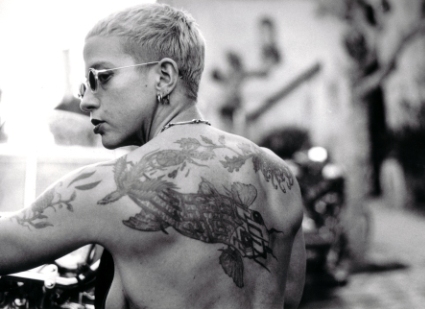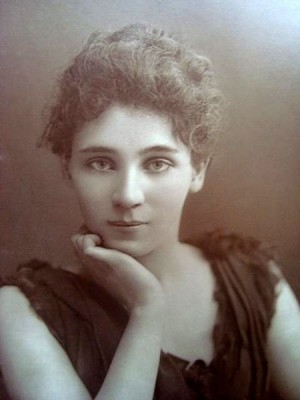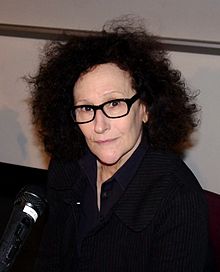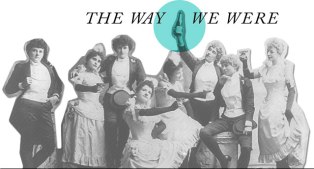June is LGBT Pride Month, so we’re celebrating all of our pride by feeding babies to lions! Just kidding, we’re talking about lesbian history, loosely defined as anything that happened in the 20th century or earlier, ’cause shit changes fast in these parts. We’re calling it The Way We Were, and we think you’re gonna like it. For a full index of all “The Way We Were” posts, click that graphic to the right there.
Previously:
1. Call For Submissions, by The Editors
2. Portraits of Lesbian Writers, 1987-1989, by Riese
3. The Way We Were Spotlight: Vita Sackville-West, by Sawyer
4. The Unaccountable Life of Charlie Brown, by Jemima
5. Read a F*cking Book: “Odd Girls & Twilight Lovers: A History of Lesbian Life in 20th-Century America”, by Riese
6. Before “The L Word,” There Was Lesbian Pulp Fiction, by Brittani
7. 20 Lesbian Slang Terms You’ve Never Heard Before, by Riese
8. Grrls Grrls Grrls: What I Learned From Riot, by Katrina
9. In 1973, Pamela Learned That Posing in Drag With A Topless Woman Is Forever, by Gabrielle
10. 16 Vintage “Gay” Advertisements That Are Funny Now That “Gay” Means “GAY”, by Tinkerbell
11. Trials and Titillation in Toronto: A Virtual Tour of the Canadian Lesbian & Gay Archives, by Chandra
12. Ann Bannon, Queen of Lesbian Pulp Fiction: The Autostraddle Interview, by Carolyn
13. 15 Ways To Spot a Lesbian According To Some Very Old Medical Journals, by Tinkerbell
14. The Very Lesbian Life of Miss Anne Lister, by Laura L
15. The Lesbian Herstory Archives: A Constant Affirmation That You Exist, by Vanessa
16. I Saw The Sign: Queer Symbols Then and Now, by Keena
17. The Ladies Of Llangollen: Runaway Romantics In 18th Century Ireland, by Una
18. 15 Awesomely Named Yet Totally Defunct Lesbian Bars Of America, by Riese
19. 6 Special Ideas About What Lesbian Sex Is, 1900-1953, by Party In My Pants
20. Queering The Library: Collecting Downtown, Riot Grrrl, Feminism & You, by Vanessa
![]()
Hey friends! Remember when I told you about the Lesbian Herstory Archives? Well now I’m going to tell you about another place that you might like if you are a queer-identified smart cookie who likes researching The Way We Were and holding things in your two little hands. This place is The Fales Library and Special Collections at New York University. It is not a lesbian-specific haven like the LHA, nor is it open to the public. However, I think it’s a very important resource for scholars and regular humans doing queer studies. It’s also relevant to examine how these pieces of queer history found their way into a large academic institution. Full disclosure, I went to NYU for my undergraduate degree, and that’s how I learned that this formidable archive exists.

via unconscious-and-irrational.blogspot.com
Once upon a time, New York University had a rare book collection that included about 150,000 volumes. The Fales Collection, as it was called, included rare books and manuscripts of English and American literature and was given to NYU in 1957 by DeCoursey Fales, in memory of his father Haliburton Fales. That specific collection is now one of several all housed under the same roof on the third floor of NYU’s Bobst Library. Officially named The Fales Library and Special Collections, it has grown to include The Downtown Collection and The Riot Grrrl Collection, effectively making it a great hub for scholars interested in using primary resources dealing with feminism, punk activism, queer theory, gender theory, the downtown New York scene, DIY culture, and music history.
Marvin J. Taylor is the current director of Fales and editor of The Downtown Book: The New York Art Scene, 1974-1984. I first met Marvin when he spoke to my Queer Literature class in 2009, but I recently sat down with him to discuss how Fales Library and Special Collections became such an obvious home for queer artifacts, why Kathleen Hanna decided to donate all her original papers to start the Riot Grrrl Collection, and what he means when he says “a thing is a slow event.” Here’s an abbreviated version of our conversation.
What inspired The Downtown Collection?
Marvin: [Fales] was really a rare book collection when I got here [in 1993]. I saw that there were all these area studies developing, like gender studies, performance studies, Asian American studies…all these areas that were breaking down traditional discipline boundaries. I thought, ‘hmm, I need to provide material to support that kind of research.’ I knew about the stuff that was happening downtown in the seventies and eighties, so I thought, ‘I bet there are collections out there.’
What does the collection look like today, almost ten years later?
Marvin: We have somewhere around 15,000 printed items, 12,000 linear feet of archival material, and 70,000 media elements. It’s the only collection of its kind and it’s the largest collection [at Fales]. I couldn’t have brought this material into any other institution that I’ve worked at because the content is just too edgy.
Can you talk about some of the most interesting queer-identified women who have work in Fales?
Marvin: Okay, obviously Kathy Acker. She’s one of my favorite writers and I like to say every queer child should read Blood and Guts in High School. In some ways it’s a bildungsroman about Janie trying to find her own voice and I love that it’s very experimental. I think it has a lot of truth in it.

Kathy Acker via theliteraryunderground.org
If we’re going to use the word queer, there are other writers who aren’t lesbians who I’d like to include. I really love Lynne Tillman and her book Haunted Houses from the early eighties. It’s the story of three different women who are coming of age and how they negotiate the performance of their own identity. I often teach it alongside Acker; they were friends.

Elizabeth Robins via en.wikipedia.org
Historically, we have a very interesting collection: the papers of Elizabeth Robins. She was an actress in Boston and she married an actor. She probably became pregnant and probably had an abortion because she wanted to continue her career. Her husband killed himself, probably because of her abortion. We have the suicide note. She kept it. She kept everything…later in life, she had relationships with women, some which were creative and some that were like Boston marriages, including a long-term relationship with Octavia Wilberforce [that lasted] until the end of Octavia’s life. She knew just about everyone from Edgar Allen Poe to Oscar Wilde to Virginia Woolf, and she was a huge force in the suffragette movement. She’s someone a lot of people don’t know about but she led a totally fascinating life and a lot can be said about different kinds of queerness in the 19th and early 20th centuries through her work.
[Please note, Wikipedia totally denies that Elizabeth Robins ever had any kind of Sapphic relations. However, I personally trust Marvin more than I trust Wikipedia. But I just thought you should know.]
We also have comics from Hothead Paisan, Homicidal Lesbian Terrorist. I always adored that work. And of course we have the Riot Grrrl Collection.
Yes! Can you tell me how that originated?
Marvin: Lisa Darms, my senior archivist, started that collection three years ago. She said, ‘I think we should start a riot grrrl collection because it’s absolutely related to punk and their activism seems a lot like the other kinds of activism we’ve collected. And Kathleen Hanna was my college roommate.’ It’s very heavily used now. Two or three people a week come in to consult the collection. I’m hesitant to speak about it though…Lisa is the expert.
[Lisa was kind enough to email back and forth with me despite the fact that she was literally on vacation while I was writing this article.]
Lisa: The idea first came up during the fall 2008 when I was interviewing for the position at Fales, and I brought Kathleen and Johanna Fateman to a Fales event that was about artists donating their papers to archives. Kathleen got really excited about the idea of a riot grrrl archive at that point, and it was something I’d always thought would be great. At that point it was just a hypothetical “what if” idea, but after I’d been at Fales for a while, I brought the idea up to Marvin, and said that Kathleen was interested in donating, and he was very excited about the idea and could see how it was a natural “sister” collection to the Downtown Collection.

The collection currently consists of 10 individual’s collections. Each collection is different, and reflects the type of activities each person was undertaking during the period, as well as what they kept. Some collections, like Kathleen’s, have a wide variety of materials, such as zine masters, handwritten lyrics, videos of performances, and photographs. Others, like the Tammy Rae Carland Zine Collection, consist entirely of zines, although most of the collections have both zines and associated material, such as correspondence from fans or people requesting zines from authors.
One might assume that as an archivist, Marvin worships physical things. However, in his email signature he includes a quote from Stanley Eveling: “A thing is just a slow event.” I asked him what he thought that meant.
Marvin: Barbara Kirshenblatt-Gimblett, who teaches Performance Studies at NYU, said it to me once. I was showing her class some materials and talking about how they deteriorate, and how sometimes we can’t do anything about it. [The quote] totally changed how I think about what I do for a living. I had this burning desire, for whatever reason, to always preserve everything forever, which is of course impossible and very frustrating. And I suddenly began to understand objects as things that are based in time that can’t last forever…it freed me to understand why I do what I do and why I preserve materials. People can learn from them but they’re in process too, and we can’t save everything no matter how hard we try. Some things will just go their natural cycle and disappear. It was soothing in a way.
Finally, how can someone visit Fales if they are not an NYU student?
Marvin: If you’re in the New York area you can apply to come in. You don’t have to be an NYU student or a student anywhere. If you’re writing something, you can apply to us for access. We have a lot of independent scholars coming in all the time.
Lisa: We have a very broad understanding of what ‘research’ is. We’ve had [traditional] scholars working on things like feminist manifestos, college students working on papers about zines or veganism and punk, but also an artist looking at the aesthetics of riot grrrl zines and flyers to inform her own paintings, and a fashion designer looking at zines to inform her own zine.

Lynne Tillman, photography by David Shankbone via en.wikipedia.org
If, like me, your goal in life is to find a project that will validate you spending hours upon hours at Fales, pouring over primary resources like Acker’s essay on the benefits of electing Prince for President and Johanna Fateman’s hate mail, then you no doubt feel thrilled by Lisa’s commentary. What is really most exciting is that not only will seasoned queer scholars work with these materials, but young undergraduate students–like myself in 2009–will stumble upon them completely by accident, and with that, new voices will be born into queer history.
I do wish the works were open for public viewing, but that’s impossible as they are part of a private university collection. And while it’s disappointing to be unable to visit the Riot Grrrl Collection whenever I please, I feel a sense of satisfaction that an established mainstream academic institution like NYU feels that these sources–pieces of our queer history–are important at all.


Vanessa is rocking the “Herstory” issue.
i just really like books/libraries/archives!
I love this too, Vanessa! Next time i’m in nyc i will probs spend my entire trip in the library
oh, i wish you could see the smile on my face right now.
This is fantastic, need to apply ASAP
can “Once upon a time” be used in everything you write like forever? Cuz really it’s just not used enough.
normally i hate applying for things because i like to just have access to what i want BUT this is something worth applying to. do you know if there has to be a purpose? or can i just write: I’d like to daydream and get moony over lesbian comics and a queered up liberry?
dear gabby,
once upon a time i forgot to respond to this comment and now idk if you’ll see it.
i will email you once i’m done and say, gabby, go look at my comment.
so!
i agree, normally i hate applying too, BUT this is definitely worth applying to i promise!
the cool thing is that you do need a purpose, but the purposes can be varied.
for example, lisa said they had “an artist looking at the aesthetics of riot grrrl zines and flyers to inform her own paintings, and a fashion designer looking at zines to inform her own zine.”
so i feel like you could build a proposal around one of your projects and it could be approved, even if you aren’t writing an Academic Research Paper.
does that make sense?
come to my apartment and let me make you brunch.
and they lived happily ever after,
vanessa
Um, WHAT. This is so amazing. I am actually going to work my damndest to get make another research trip up to NYC before I leave the East Coast this summer. Though, in all honesty, I pretty much have a Riot Grrrl archive in my house.
a riot grrrl archive in your house?! i am going to have to write a post about your house next. that sounds creepier than i meant it to sound…but yes, make a research trip! it is so worth it, i promise.
I definitely need to visit NYC soon to see this collection! It’s so important that bodies of knowledge have knowledge of bodies, especially queer ones!
Riot Grrrrl! I like it. Us queer ladies need artistic collections too lol. Seriously, I’m proud to be here and to be queer. Cheers to this blogger.